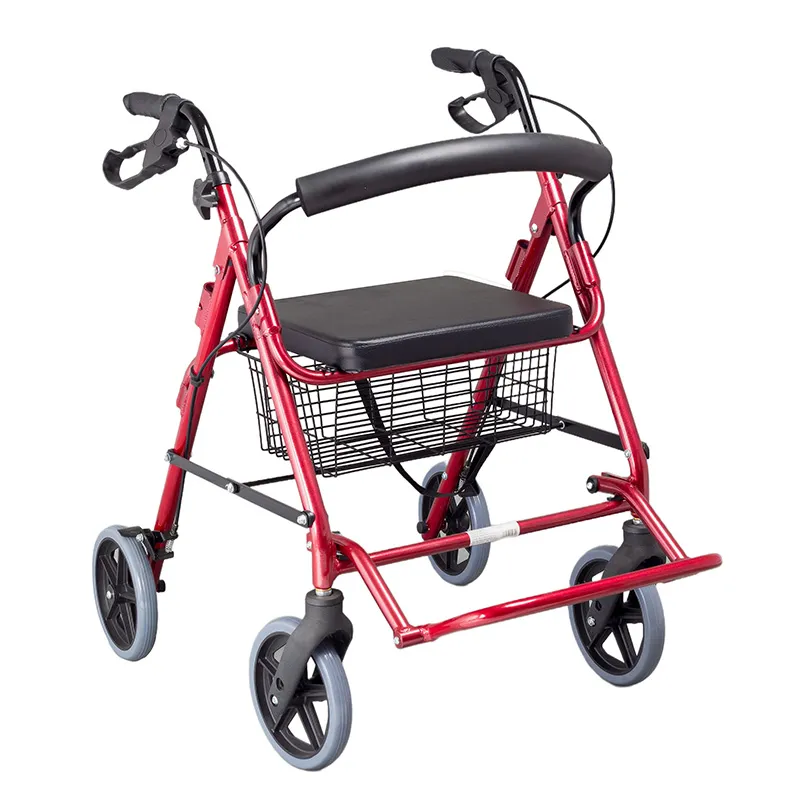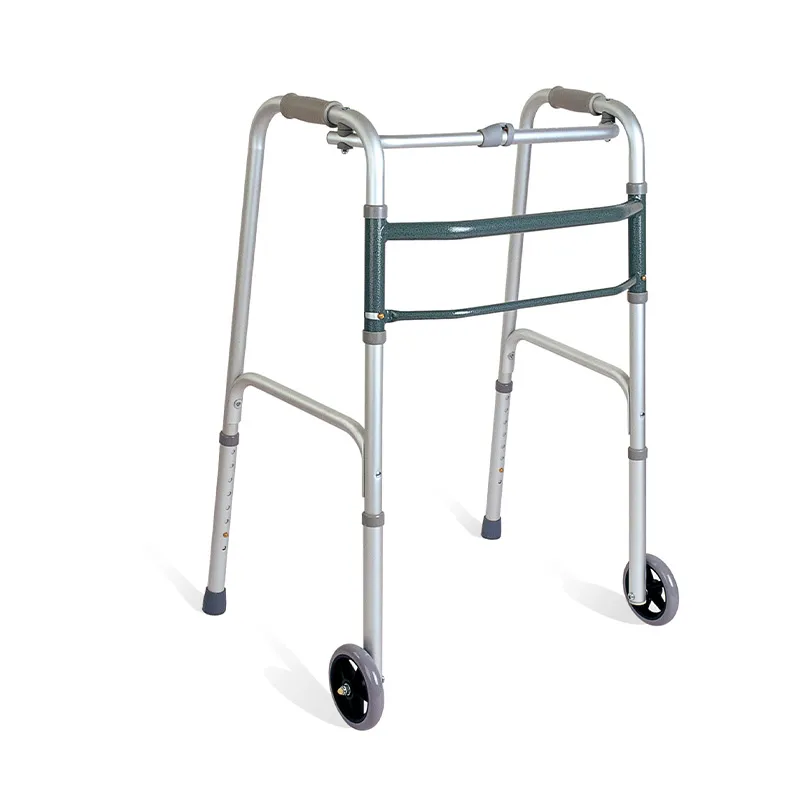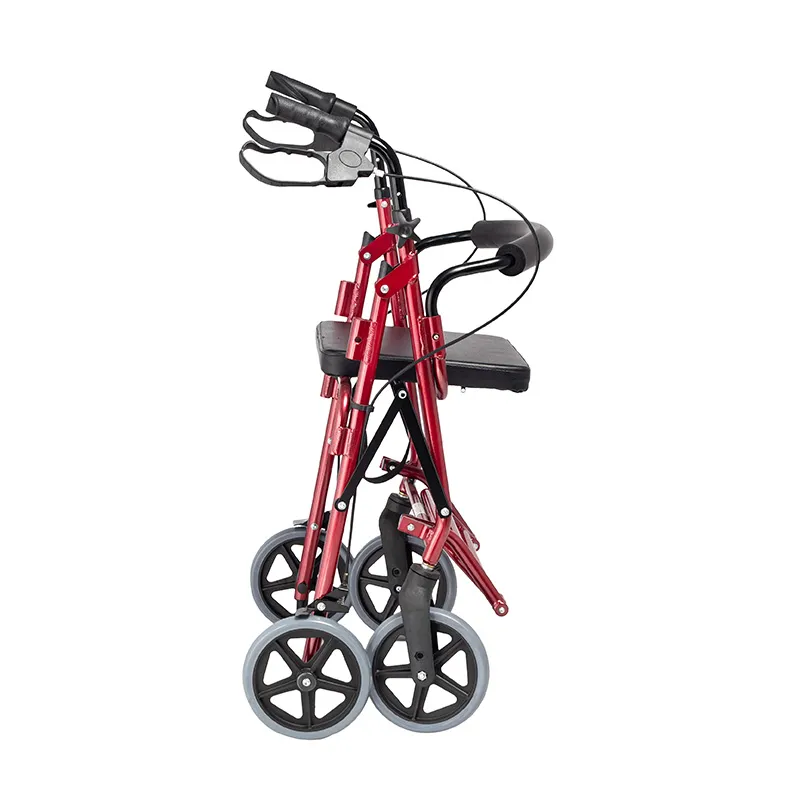
What are the Pros and Cons of rollator walker and walking frame?
2024-08-22 15:30
In today's society, mobility aids are becoming more and more important for people with limited mobility, especially the elderly. Rollator walker and walking frame are two common walking aids. They have significant differences in design, function and applicable groups.
So, what are the advantages and disadvantages of rollator walker and walking frame? Which one is better? This article will provide an in-depth analysis to help you make a more informed choice.

Basic introduction to rollator walker and walking frame
1. rollator walker
A rollator, also known as a rollator walker, is usually equipped with four wheels, a seat and a braking system. Its main features are:
● Wheels: Four wheels make the rollator easier and more flexible to move on various surfaces.
● Seat: The built-in seat allows users to rest at any time when needed.
● Braking system: The handbrake and footbrake systems ensure that users can stop at any time during movement, providing additional safety.
● Storage Basket: Many rollators also come with storage baskets or bags to make it easier to carry items.
2. Walking Frame
Walking Frames usually have no wheels, or only have two front wheels with rubber feet behind them, requiring the user to lift the frame and move it forward. Its main features are:
● Wheelless or few-wheel design: The traditional Walking Frame has no wheels, while some modern Walking Frames are equipped with two front wheels to increase flexibility.
● Stability: With no wheels or only two front wheels, walking frames provide greater stability and support.
●Simple structure: Walking Frame has a simple structure, usually made of lightweight metal, making it easy to carry and use.

What is the difference between rollator walker and Walking Frame?
1. Design and structure
● rollator walker: a more complex design, equipped with four wheels, a seat and a braking system. Suitable for users who need to move frequently and often need to rest.
● Walking Frame: Simple design, no wheels or only two front wheels. Mainly to provide stable support, suitable for users who have difficulty moving and require higher stability.
2. Movement method
● rollator walker: Users can easily push the rollator to move. The design of the wheels allows it to move flexibly on various surfaces, making it suitable for long-distance walking.
● Walking Frame: Users need to lift the walking frame to move forward. The wheelless design makes it more suitable for short-distance movement or standing support.
3. Applicable people
● Rollator walker: suitable for the elderly or rehabilitation patients who have weak leg strength but need to move frequently and have a certain walking ability.
● Walking Frame: Suitable for users who require high stability and support and have poor mobility, such as patients recovering from surgery.
4. Security
● rollator walker: Equipped with a braking system, which increases safety during movement and prevents sliding and falling.
● Walking Frame: Since there are no wheels or only two front wheels, it provides higher stability and is not easy to slide, but when it needs to be moved, the operation is more laborious.

What are the advantages and disadvantages of rollator walker and walking frame?
1. Advantages and disadvantages of rollator walker
Advantages of rollator walker:
● High flexibility: The four-wheel design allows the rollator walker to move flexibly on various surfaces, making it suitable for outdoor use.
● Convenient for resting: The built-in seat allows users to sit down and rest at any time when they feel tired.
●Additional functions: Storage basket and bag design make it convenient for users to carry items.
● Safety: The braking system provides extra safety to prevent slipping and falling.
Disadvantages of rollator walker:
● Heavy weight: The design of the rollator walker is relatively complex and the weight is relatively large, making it inconvenient to carry and carry.
● Space occupied: The rollator walker occupies a large space and is not suitable for small indoor environments.
● Higher cost: Due to its complex design, the price of a rollator walker is usually higher than that of a walking frame.
2. Advantages and Disadvantages of Walking Frame
Advantages of Walking Frame:
● High stability: The Walking Frame has no wheels or only two front wheels, providing highly stable support and suitable for users who need additional support.
●Light weight: Walking Frame has a simple structure and light weight, making it easy to carry and use.
● Small space occupied: Walking Frame takes up less space and is suitable for small indoor environments.
● Lower cost: The design of Walking Frame is relatively simple and the price is usually lower.
Disadvantages of Walking Frame:
● Low flexibility: There are no wheels or only two front wheels. The Walking Frame needs to be lifted when moving. The operation is laborious and not suitable for long-distance walking.
● Fewer functions: There is no seat or storage function, and users may feel inconvenienced when using it for a long time.

Which one is better, rollator walker or walking frame?
Rollator walker and Walking Frame each have their own advantages and disadvantages, and their applicable groups and usage scenarios are also different. Therefore, we cannot simply say which device is better, but the choice must be based on the user's specific needs and usage environment.
1. Suitable for rollator walker users:
● Elderly people who need to move frequently: The four-wheel design and built-in seat of the rollator walker are suitable for elderly people who need to move frequently and take frequent breaks.
● Users with weak physical strength but certain walking ability: The flexibility and additional functions of the rollator walker can provide a better walking experience for such users.
● Users who need to use it outdoors: The rollator walker can move flexibly on various surfaces and is suitable for users who need to walk outdoors.
2. Suitable for Walking Frame users:
● Users who require a high degree of stable support: The design of the Walking Frame provides higher stability and is suitable for users with poor mobility who need additional support.
● Patients in the postoperative recovery period: Walking Frame is suitable for patients in the postoperative recovery period, providing the necessary support and stability to help them gradually regain their walking ability.
● Users who mainly use it indoors: Walking Frame takes up little space and is suitable for use in small indoor environments.
In conclusion
Rollator walker and Walking Frame each have their own unique advantages and applicable scenarios. The rollator walker is suitable for seniors who need to move frequently with its flexibility and versatility, while the Walking Frame is suitable for users who need a high level of support with its stability and simple design.








